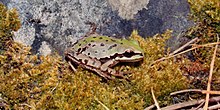pt-BR
nomes no trilho de navegação


Dryophytes eximius, commonly known as the mountain tree frog, is a species of frog in the family Hylidae endemic to Mexico.[2] Its natural habitats are mesquite grasslands, scrub forests, and pine-oak forests. It is a widely distributed species that faces no major threats.[1]
Dryophytes eximius is listed as the state amphibian of Arizona.[3] As currently circumscribed, Dryophytes eximius does not occur in Arizona. Dryophytes wrightorum, the Wright's mountain tree frog, which has previously been regarded as a synonym of Dryophytes eximius does occur in Arizona.[4]
 Mountain Treefrog, (Dryophytes eximius), Municipality of Gómez Farías, Tamaulipas, Mexico (27 May 2005).
Mountain Treefrog, (Dryophytes eximius), Municipality of Gómez Farías, Tamaulipas, Mexico (27 May 2005). Dryophytes eximius, commonly known as the mountain tree frog, is a species of frog in the family Hylidae endemic to Mexico. Its natural habitats are mesquite grasslands, scrub forests, and pine-oak forests. It is a widely distributed species that faces no major threats.
Dryophytes eximius is listed as the state amphibian of Arizona. As currently circumscribed, Dryophytes eximius does not occur in Arizona. Dryophytes wrightorum, the Wright's mountain tree frog, which has previously been regarded as a synonym of Dryophytes eximius does occur in Arizona.
Hyla eximia, ahora Dryophytes eximius, es una especie de anfibios de la familia Hylidae. Es endémica de México.[1][2] Sus hábitats naturales incluyen bosques templados, montanos secos, praderas a gran altitud, ríos, corrientes intermitentes de agua, pantanos, marismas de agua dulce y corrientes intermitentes de agua.
Esta rana mide entre 1.9 a 5.6 cm de largo. Su piel es verde o marrón con rayas oscuras a los largos de su cuerpo. La rana macho adulta tiene una garganta marrón. La hembra adulta tiene una garganta blanca.[3]
Una de las amenazas para esta rana es que los humanos las atrapen para venderlas como mascotas. Esta rana produce químicos tóxicos en su piel. Las personas que han tocado esta rana reportan dolor después de tocarse los ojos.[3]
Hyla eximia, ahora Dryophytes eximius, es una especie de anfibios de la familia Hylidae. Es endémica de México. Sus hábitats naturales incluyen bosques templados, montanos secos, praderas a gran altitud, ríos, corrientes intermitentes de agua, pantanos, marismas de agua dulce y corrientes intermitentes de agua.
Esta rana mide entre 1.9 a 5.6 cm de largo. Su piel es verde o marrón con rayas oscuras a los largos de su cuerpo. La rana macho adulta tiene una garganta marrón. La hembra adulta tiene una garganta blanca.
Una de las amenazas para esta rana es que los humanos las atrapen para venderlas como mascotas. Esta rana produce químicos tóxicos en su piel. Las personas que han tocado esta rana reportan dolor después de tocarse los ojos.
Hyla eximia Hyla generoko animalia da. Anfibioen barruko Hylidae familian sailkatuta dago, Anura ordenan.
Dryophytes eximius est une espèce d'amphibiens de la famille des Hylidae[1].
Cette espèce est endémique du Mexique. Elle se rencontre entre 910 et 2 900 m d'altitude dans la Sierra Madre Occidentale, la Sierra Madre Orientale et la Cordillère néovolcanique[2] :
Dryophytes eximius est une espèce d'amphibiens de la famille des Hylidae.